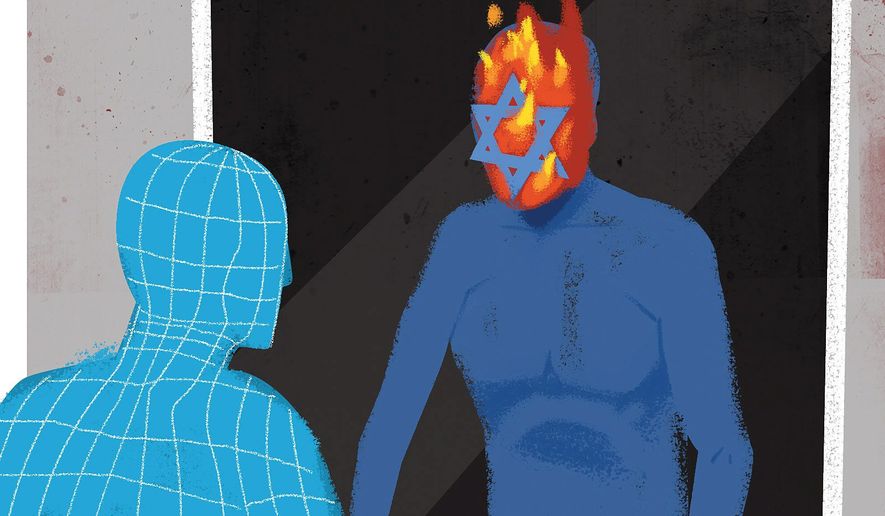OPINION:
Antisemitism is back with a vengeance. According to the Anti-Defamation League (ADL), acts of assault, vandalism, and harassment against Jews are at the highest level “since ADL’s tracking began in 1979.”
One example: This month, Khaled Awad, an immigrant from Egypt, was charged with stabbing a rabbi outside a Jewish school in Boston. Witnesses said, “the suspect would stereotype various differences in racial groups and behavior, which included Whites, Blacks and that he was especially harsh on Jews.” (If that sounds like qualifications for a tenured professorship at an elite university, perhaps that’s part of the problem.)
Truth be told, antisemitism never completely disappeared. Following World War II, as the depth of the depravity encapsulated in the anodyne-sounding phrase “final solution to the Jewish question” became clear, there was, in America and Europe, revulsion against hatred based on race, creed, and color, along with a belief – or perhaps just a hope – that the new United Nations and the “international community” would say “Never Again!” to genocide and mean it.
The peoples of the Middle East, however, for years had imbibed Nazi ideology, in no small measure due to Amin al-Husseini, the British-appointed Grand Mufti of Jerusalem who spent the war in Germany assisting Hitler, including by broadcast propaganda to the region in Arabic.
One by one, these countries went on to expel their Jewish citizens – and not only Zionists (meaning supporters of self-determination for the Jewish people in part of their ancient homeland). More than 750,000 Jews were driven out of Iraq, Egypt, Libya, and other lands where their families had lived for centuries. Many went to Israel, thereby strengthening the fledgling Jewish state. In much of the Arab world, vehement variants of antisemitism persist to this day.
Any attempt to understand this ancient hatred must include serious reflection on when and where it metastasized most lethally: Germany in the 1930s and ‘40s.
“Jews and Germans: Promise, Tragedy, and the Search for Normalcy,” published last year, accomplishes that mission. The author is Guenter Lewy, a professor emeritus of political science at the University of Massachusetts-Amherst.
Born in Germany in 1923, he lived for six years under Nazi rule, fleeing to Palestine in early 1939, where he worked on a kibbutz. “In late 1942, with General Rommel’s divisions threatening an imminent assault on the Jewish home in Palestine,” he writes, “I volunteered for the British Army.” He fought in Egypt and Italy. After the war, he served as an interpreter for the British military in occupied Germany. In 1946, he came to the U.S., where he has taught, studied, and written 17 books.
Jews first settled in what is now Germany in the 4th century under the Roman Emperor Constantine. By the end of the 19th century, there were more than half a million German Jews. Though less than one percent of the country’s population, Mr. Lewy writes, a significant number had become prominent “in literature, music, the theater, journalism, science, and many other fields,” winning 12 Nobel Prizes.
The Weimar Republic, founded after Germany’s defeat in World War I, was “a high point of Jewish emancipation and assimilation,” a period when, Mr. Lewy writes, German Jews “became ministers, mayors, civil servants, and full professors at universities.”
“The great majority of German Jews considered themselves primarily German, with the Jewish part – religion or ethnicity – playing a subordinate role,” he adds. As for antisemitism, most German Jews initially dismissed it as a “relic of the past that would soon be overcome.”
What happened next: In 1933, following election victories by the Nazi Party, Hitler was appointed Germany’s chancellor.
With optimism, energy, and determination, German Jews attempted to overcome – or at least reduce the ferocity of – antisemitism through truth-telling and appeals to their fellow citizens’ sense of decency and tolerance.
One example: Nazis denigrated Jews as “cowardly shirkers” who had avoided service in the Great War. In truth, as Mr. Lewy writes: “Out of a population of about 500,000 Jews, 100,000 had served their country, about 80,000 of them in the front lines. The percentage of Jewish volunteers was higher than in the German population at large. About 35,000 Jews had been decorated, and at least 12,000 had been killed.”
Jewish groups publicized such facts – to no avail. The Nazis regarded Jews as an inferior race, Untermenschen, and neither demonstrations of loyalty to the Fatherland nor even religious conversion could change that. The Nazis viewed history as a great racial struggle, one that the superior race would ultimately win, the master race, the so-called Aryan race.
So, once the Nazis took power, there were acts of assault, vandalism, and harassment against Jews, eventually culminating in the Holocaust, the Shoah, the slaughter of six million Jews.
Despite the defeat of the Nazis, Judenhass, the hatred of Jews, or Judeophobia, to use a modern term, continues to infect prominent individuals in Europe and America, on both the right and the left.
The leaders of Hamas and the rulers of Iran are, openly and proudly, Islamic supremacists, which implies they regard Jews – though not just Jews – as Untermenschen, with no right to equality (much less equity).
In the 20th century, the goal of extreme Jew-haters was the extermination of the European Jew. As Mr. Lewy’s book makes clear, that was not widely understood until it was too late. And Jews who did see what was coming hadn’t the means to defend themselves.
In the 21st century, the goal of the most extreme Jew-haters is the extermination of Israel, the Jew of nations. Most Israelis do understand that and are doing what they believe must be done to defend themselves. If you are an anti-antisemite, you support that.
• Clifford D. May is the founder and president of the Foundation for Defense of Democracies (FDD) and a columnist for the Washington Times.




Please read our comment policy before commenting.